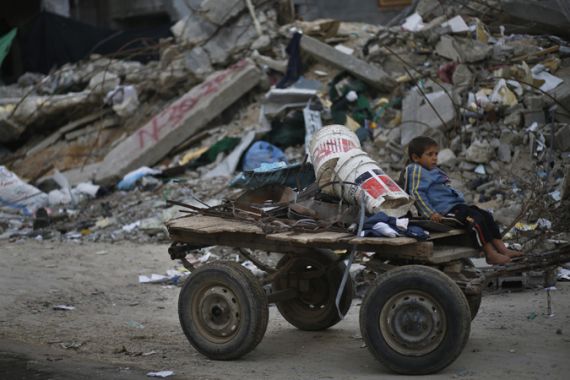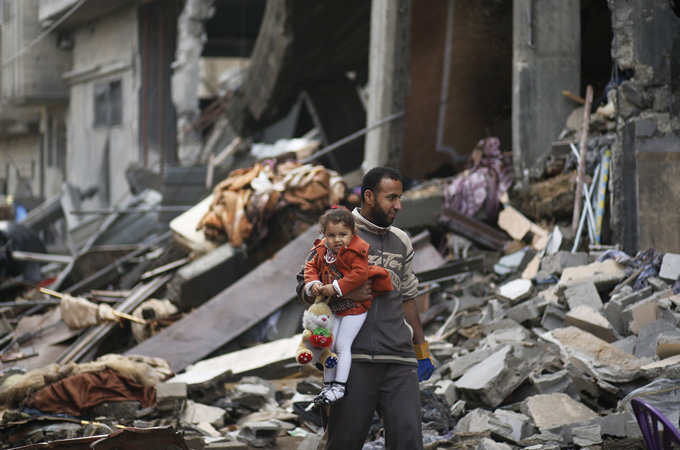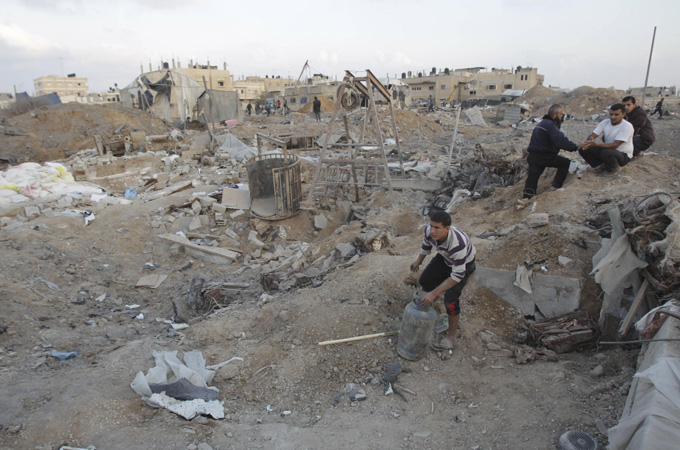Reporter’s Notebook: Redefining resilience
When Israeli airstrikes struck Gaza simply continuing with daily life became a small act of resistance for Gazans.

Within hours of the Israeli attack on the Hijazi family home in Jabaliya refugee camp, in which three members were killed and seven others critically wounded, the family’s neighbours and other camp residents were at the obliterated site, picking at its remains.
Children, perched on blocks of rubble, paused their chatter to say, not in anguish but rather matter-of-factly: “We are used to this. Every year there is a war against all of us.”
Tears were not shed, chests were not beaten, and wails were not heard from the crowd. Instead, heads were kept down as they dutifully gathered the few belongings scattered on the ground, placing them in a pile for the remaining survivors, before they each returned to their daily routines.
 |
| A Palestinian man carries his daughter as they pass houses witnesses say were damaged during Israeli airstrikes [Reuters] |
Returning to their day-to-day activities in no way reduces the value of lives lost – a misconception often perpetuated by media organisations who tend to overlook the significance of the impact living under occupation for over half a century can have on a population.
Rather, returning to their day-to-day activities appears to embolden Gazans to continue with their struggle for existence. Those killed have not died in vain, because the population continues to honour their memory by remaining steadfast. In that sense, even going to work every morning becomes an act of resistance.
Houses across the Strip opened their doors to friends and relatives fleeing vulnerable areas. Hotels and offices gave beds to employees to ensure work continued. Elaborate plans were made and new routes drawn out to ensure employees could get home safely each night.
“This is how we resist,” explained one 10-year-old boy, standing on the periphery of a bomb site. “This is why we are not scared of their war.”
‘Popping balloons’
Midway through the eight-day-long ‘Second War’, as it was dubbed by Gaza residents, a taxi driver dropped us off at the office.
Getting back in his car, he said: “I’ll be back in an hour, God willing. But if a missile hits me, don’t worry, [the taxi company] will send you someone else to drive [you] around.”
My colleague Majed laughed: “See? Even in a war we want to make sure your work doesn’t get interrupted.”
 |
| Gaza residents called November’s conflict the ‘Second War’ [Reuters] |
Incidentally, the driver who was originally meant to pick us up that morning was in hospital after being hit by shrapnel from an Israeli missile that landed on the road as he came to meet us.
Meanwhile, parents thought of creative ways to quell the fears of their young children. “Every time a bomb hit, we would wave it away and say it was the wind,” explained one parent. Another convinced his four-year-old son that the sound of the bombs was just balloons popping.
The residents of Gaza are fully aware that while Israelis have state-of-the-art warning systems that alert them to hide in bomb shelters, the Palestinians have nothing to protect them against the bombs hitting targets in densely populated areas.
Yet the mere fact that rockets were able to reach both Tel Aviv and Jerusalem boosted the morale of some; a major difference between today and the first war in 2008.
“We managed with our small weapons to get the Israelis into shelters,” exclaimed one woman celebrating. “We thank the resistance for hitting Tel Aviv.”
Children wrote fierce poems recounting their experiences, living the moments over again with each word. “Were we scared? Yes, but the Israelis were more scared,” was a recurrent theme.
Delving deeper
Two main themes seemed to have emerged within a large proportion of the media when discussing the reactions of the Palestinian people. They were either described as a people desperately seeking martyrdom, to whom death is ‘cheap’, or they were portrayed as a people who are destitute and powerless in face of constant attacks.
As news media, we often tend to fall into the trap of fetishising our news stories and their characters, and the characters of Gaza have been sketched in ways that skew them towards these distorted archetypes.
Yet they are neither. The residents of Gaza are just people, and their reactions are a testament to how human beings will constantly try to find ways to live, even in the most unlivable conditions.